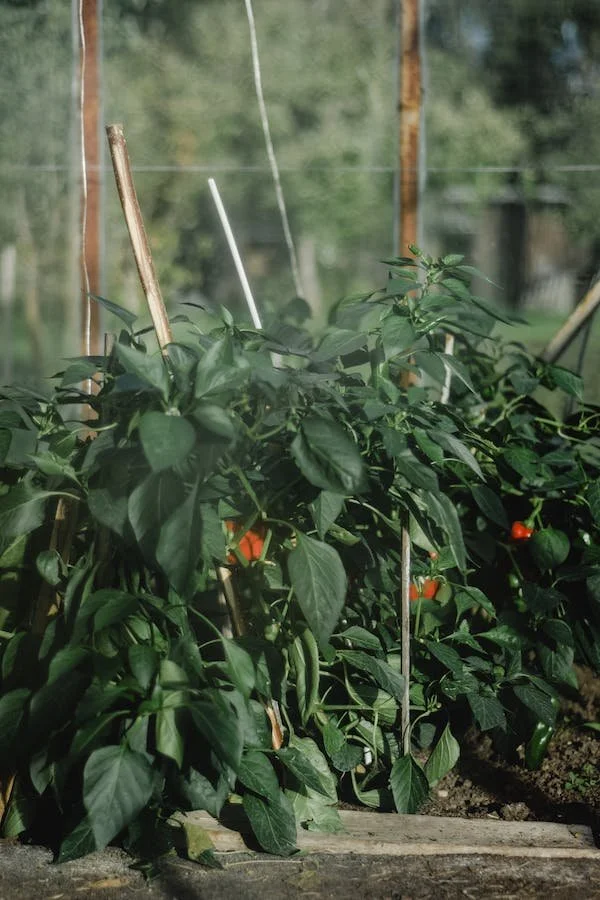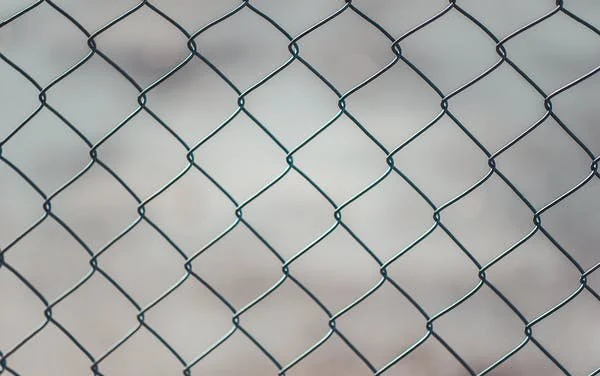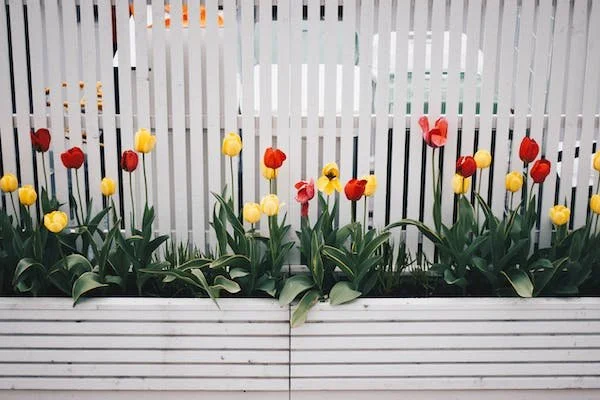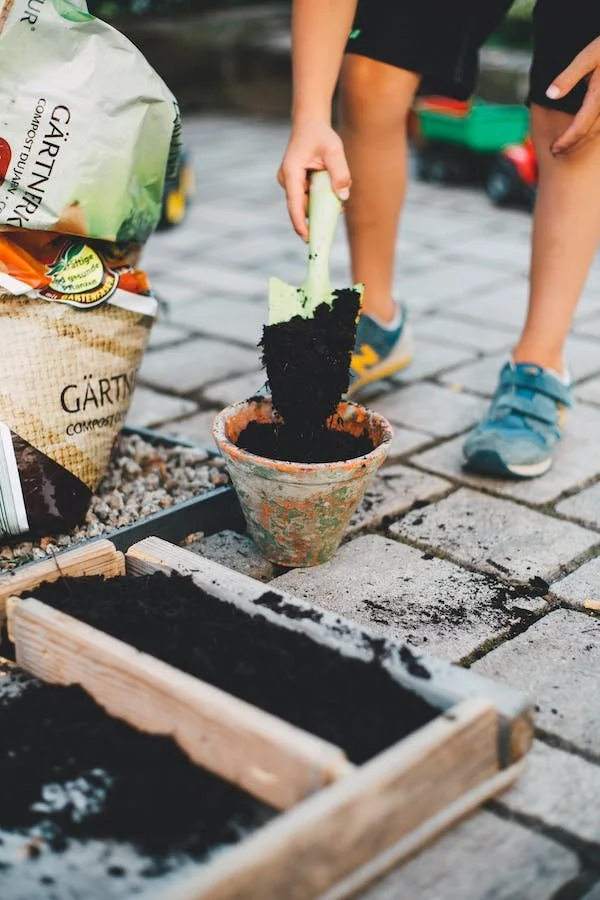
A resource for those seeking information on organizing and transforming spaces.
4 Easy Tips for Veganic Gardening
Eco-friendly and nonexploitative –– that's just another way of saying healthy for humans and good for the Earth. The goals of veganic gardening –– gardening without the use of any animal products –– can seem intimidating to beginners, but break it down into the main principles, and it's easy to be a veganic gardener, especially if you follow four easy tips:
Eco-friendly and nonexploitative –– that's just another way of saying healthy for humans and good for the Earth. The goals of veganic gardening –– gardening without the use of any animal products –– can seem intimidating to beginners, but break it down into the main principles, and it's easy to be a veganic gardener, especially if you follow four easy tips:
1. Attract Bees
Honeybees are the key to a veganic gardener’s success. Attract honeybees to your garden by planting flowers they love, alongside your fruits and vegetables. Honeybees love lavender, bee balm, peony, and milkweed. Mint and sage are two herbs that bees love as much as humans do. Nasturtiums, zinnias, and black-eyed Susans add a pop of color to your garden while attracting the bees. The more you encourage bees to make themselves comfortable in your garden, the more they will go about pollinating and helping your vegetables grow into something you can put on the table.
2. Composting Is King
Chemical fertilizers, while rich in nitrogen, potassium, and phosphate, can burn your skin on contact, and they’re obviously not organic. Animal fertilizers, such as manure, are animal byproducts and therefore not vegan. So what’s the vegan option? Veganic gardeners get great results by using plant products, such as hay, to mulch and add nutrients to the soil.
Your compost from a vegan kitchen is essential for fertilizing a veganic garden. If you're new to veganism or live with someone who's not vegan, make sure you separate all animal products from any kitchen scraps you compost. Composting requires three things — the “brown” or leaves and twigs from the outdoors, the “green” or scraps from your kitchen, and water. Add a little time, and some turning over, and it's an Earth-friendly way to fertilize your garden, without the chemicals contained in mass-market fertilizers.
3. Strike a Natural Balance
There’s no pest-killing allowed in veganic gardening. Pesticides not only kill their intended targets, but they also harm unintended living beings as well. That doesn't mean you're at the mercy of plant-eating insects though. Veganic gardeners promote a natural balance of predators and prey that live among the vegetables. If you have aphids, you can introduce ladybugs. If birds are raiding your garden, a scarecrow or fake owl may keep them away. Companion planting is another way to protect your fruits and vegetables. Basil and borage should be planted next to tomatoes to repel tomato hornworms. A few marigolds in your vegetable garden will attract the bees and wasps that pollinate your plants and eat other leaf-eating insects.
4. No Weed-Killing Chemicals
Consider the lawsuit filed by DeWayne Johnson, a school groundskeeper. He sued Monsanto, alleging that his cancer was due to protracted exposure to Roundup weed killer on the job. The jury awarded him $298 million in August 2018. Monsanto is appealing, and the U.S. Environmental Protection Agency still says that glyphosate, the active ingredient in Roundup and other weed killers, is safe if used properly. But if you’re not willing to take a chance, remove all weeds by hand.
Veganic gardening is an excellent and sustainable way to support your already environmentally friendly lifestyle. It can not only lead you to a healthier diet but to a better understanding of the Earth and its creatures. These four easy tips for veganic gardening should lead you to take a close look at what you're planting and the purpose it serves. You'll also have peace of mind about the way your food is produced.
Useful guide to better garden security
If you're a gardener, you know how much work goes into cultivating your plants, flowers, and vegetables. Garden security is essential to ensure that all of your hard work and investments are protected. Garden theft is becoming more common, so it's important to take steps to secure your garden. Here are some tips to help you improve your garden security.
If you're a gardener, you know how much work goes into cultivating your plants, flowers, and vegetables. Garden security is essential to ensure that all of your hard work and investments are protected. Garden theft is becoming more common, so it's important to take steps to secure your garden. Here are some tips to help you improve your garden security.
Use motion sensor lights
Installing motion sensor lights is an effective way to deter thieves from entering your garden at night. When someone walks into the sensor's range, the light will turn on, which can startle potential thieves and draw attention to their presence. Make sure to place the lights in areas where thieves are likely to enter, such as near your garden gate or in dark corners of your garden. Additionally, consider installing solar-powered lights, which are more cost-effective and environmentally friendly than traditional wired lights.
Consider a security camera
Security cameras are a great way to keep an eye on your garden, especially if you're not always at home. You can install cameras around your property and connect them to your smartphone or computer to monitor your garden remotely. Make sure to choose a camera with high-resolution video quality and night vision capabilities. Additionally, make sure the camera is installed in a secure location where thieves can't easily tamper with it.
Lock up your tools
Garden tools are often targeted by thieves because they're easy to resell. Make sure to lock up your tools in a shed or garage when they're not in use. You can also invest in a lockable tool storage unit, which can be mounted on a wall or kept on the ground. When choosing a storage unit, consider one that is weather-resistant and large enough to store all of your gardening tools.
Install a fence
A fence is a great way to deter thieves and unwanted visitors from entering your garden. When choosing a fence for your garden, consider opting for a solid fence that is high enough to prevent people from climbing over it. Additionally, make sure your fence is locked at all times, and consider adding spikes or barbed wire to make it more difficult for someone to climb over. If you have a smaller garden or a balcony, you can consider using a trellis or netting to enclose your garden. Of course, this is a process that needs to be done properly, so consider looking into experienced handyman services and make sure you find people who will install your fence adequately and professionally.
Use thorny plants
Thorny plants such as roses or blackberry bushes can act as a natural deterrent to thieves. Planting these types of plants around the perimeter of your garden can help deter thieves from entering. Additionally, thorny plants can also help keep pests out of your garden. Make sure to choose plants that are suitable for your climate and soil type, and consider using a variety of thorny and non-thorny plants to create a natural and attractive garden.
Secure your garden gates
Garden gates are often a weak point in garden security. Make sure your gate is locked and consider adding a padlock or combination lock to make it more secure. Additionally, make sure the hinges are secure and that the gate is sturdy enough to prevent someone from forcing it open. If you have a large garden or multiple entrances, consider installing a gate alarm. This will alert you if someone tries to enter your garden without your knowledge.
Be mindful of what you post on social media
Sharing photos of your garden on social media is a great way to connect with other gardeners, but it's important to be mindful of what you're sharing. Avoid sharing your exact location or any other personal information that could make it easier for thieves to target your garden. Additionally, avoid posting about any expensive or valuable plants or equipment that you may have in your garden. Thieves often use social media to identify potential targets, so it's best to keep your garden activities private.
Get to know your neighbors
Building relationships with your neighbors is a great way to improve garden security. You can ask them to keep an eye on your garden when you're away, and you can return the favor by watching their property. Additionally, having more people keeping an eye on your garden can help deter potential thieves. If you have a neighborhood watch program, consider joining it or starting one. This can be a great way to improve garden security and overall safety in your community.
Garden security is an important aspect of gardening that shouldn't be overlooked. By taking steps to secure your garden, you can protect your hard work and investment. Installing a fence, using motion sensor lights, and considering a security camera are all effective ways to deter thieves. By implementing these tips, you can enjoy your garden without worrying about theft or vandalism!
Useful Tips on How to Stay Safe While Gardening
Gardening is a great way to spend your time, whether you're growing your own fruits, vegetables, or flowers. However, it's important to keep safety in mind when doing that, which is something lots of people forget to do. This is why they end up getting hurt or seriously injured, and that’s something we should all try to avoid. Therefore, here are a few tips to help you stay safe while working in your garden.
Gardening is a great way to spend your time, whether you're growing your own fruits, vegetables, or flowers. However, it's important to keep safety in mind when doing that, which is something lots of people forget to do. This is why they end up getting hurt or seriously injured, and that’s something we should all try to avoid. Therefore, here are a few tips to help you stay safe while working in your garden.
Use the right tools
Using the right gardening tools for the task at hand is also important for safety. Using a hand trowel for planting small plants, for example, and a spade for digging will make your work easier and reduce the risk of injury. Make sure to keep your tools in good condition by sharpening blades and oiling moving parts regularly to ensure that they work properly and safely.
Read the labels
If you use pesticides or fertilizers, always read the label and follow the instructions carefully. Use them only in the recommended amounts and wear protective gear when applying them. When working with power tools, such as lawnmowers, trimmers, and chainsaws, always read the manual and follow the instructions. This will help to reduce the risk of injury.
Get in better physical shape
Even though it may not seem that way, the fact is that gardening is harder and more demanding than you can imagine. Pay attention to your posture and movements, try to avoid repetitive motions, take frequent breaks and stretch your muscles to avoid strain and injury. This is important for maintaining good ergonomics and avoiding injuries.
Wear protective gear
Wearing protective gear is essential when working in the garden. Always wear gloves, long pants, and closed-toe shoes to protect your hands and feet from cuts, scrapes, and punctures. Using work clothes made by professionals is a great way to go and the only way to save each part of your body from getting hurt. Additionally, wear sunglasses or a wide-brimmed hat to protect your eyes from the sun. This will also protect your skin from sunburn and other damage.
Stay hydrated
Staying hydrated is essential for staying safe while working in the garden. The body loses water through sweating and breathing, especially when working in hot and humid weather. When the body is dehydrated, it can cause fatigue, dizziness, and other symptoms that can lead to accidents or injuries. Staying hydrated is also important for safety when working in the garden. Drink plenty of water to stay hydrated, especially on hot days. This will help to keep you from becoming fatigued and reduce the risk of heat-related illnesses.
Make sure you know what you’re doing
Be aware of your surroundings when working in the garden. Look out for hazards such as uneven ground, low-hanging branches, and poisonous plants. Also, be aware of the weather, if it's too hot or humid it might be better to work in the morning or evening. Properly maintaining your tools will also help you to stay aware and safe while working in your garden.
Learn more about your plants
Another important aspect to consider when working in the garden is to be familiar with the plants and trees you are working with. Some plants may have thorns, spikes, or other harmful features that can cause injury. Additionally, some plants may be poisonous or allergenic, so it's important to know what you're dealing with before you start working. Make sure to research the plants you have in your garden and be aware of any potential dangers.
Think about elevated surfaces
Another thing to consider is the use of ladders or other elevated surfaces. When working on elevated surfaces, always use a sturdy ladder that is appropriate for the task, and be sure to follow safety guidelines. Always face the ladder while climbing up or down and make sure to keep at least one hand on the ladder at all times. Never overreach or lean out too far, and always use a ladder that is the right height for the job.
Get a first-aid kit
Lastly, it's important to havea first-aid kit on hand at all times. Accidents can happen, even when you're being careful, so it's best to be prepared. Your first-aid kit should include band-aids, antibiotic ointment, and a basic pain reliever. If you're working with power tools or chemicals, you should also have a pair of safety goggles, and dust masks in your kit. Make sure your first-aid kit is easily accessible and you know where it is in case of an emergency.
By following these tips, you can stay safe while working in your garden. Remember, taking the time to be safe will help you to enjoy your gardening experience more and reduce the risk of injury. Also, it's important to seek medical attention right away if you have any accident or injury while working in the garden. It's better to be safe than sorry.
3 Ideas for Decorating the Fence Surrounding Your Garden
Planting a lovely flower garden or vegetable patch is the perfect way to celebrate the growing season. To keep your plants healthy and safe, install a fence to prevent hungry wildlife from eating their fill of your blossoms and produce. To make the most of your cultivated area, add a decorative accent to your fence.
We partnered with Creating Relations. for this post. The opinions in the post are honest. All reviews and opinions expressed in this post are based on our personal views. We are excited because we know you will love it.
Planting a lovely flower garden or vegetable patch is the perfect way to celebrate the growing season. To keep your plants healthy and safe, install a fence to prevent hungry wildlife from eating their fill of your blossoms and produce. To make the most of your cultivated area, add a decorative accent to your fence.
Metal Fences
A metal fence offers stability and garden security from neighbors' pets, wildlife, and trespassing kids. This design comes in various styles and an array of colors to match your home's exterior or your garden theme. Metal fences can be adorned with painted images or suspended plaques that convey seasonal or holiday motifs. Constructed in sections, they are easy to install and maintain for year-round use, and the length can be extended, reduced, or configured as needed. Made of polypropylene to withstand harsh heat and extreme cold, this type of fencing is durable for any kind of garden. Fencing contractors can help you decide on which fence is going to be best for your land. You may not know all the types of fences available, and having an expert guide you will help you decide what's best.
Chain Link Fencing
Galvanized steel chain link fencing makes a strong border to any garden. Sturdy and tough, they hold their shape and structure in most weather conditions. You can beautifully decorate this type of fence by threading colorful ribbons through the mesh wiring or hanging coordinated flower baskets of your favorite blossoms. Drape colorful outdoor flags with a theme or design that works with the garden arrangement. White or colored lights can be strung across the fence for a festive effect. You can plant seasonal blooms along the fence as a natural border to enhance the fencing with a layered look.
Wood Fences
For a traditional look, you can't beat a wood fence. Whether split rail or connecting panels, your garden's beauty will be enhanced by a natural-looking fence that is made of real wood or composite materials. A wood fence looks great with natural elements like a birdhouse hung on a peg, trimmed with bows during the holidays, or painted in a color that goes with your home's exterior finish. Climbing vines or flowering plants like clematis or rambling roses add color and fragrance to your garden retreat.
Whatever your choice of fence, there are numerous decorating options to consider. Many types of decor will work with all these fencing styles. You may want to consider how the fence and its decorations will match or mesh with your home's exterior decor. An attractive fence will make your garden all the more relaxing and enjoyable.













